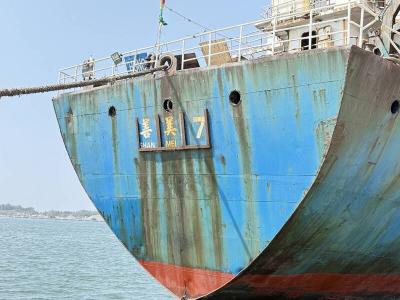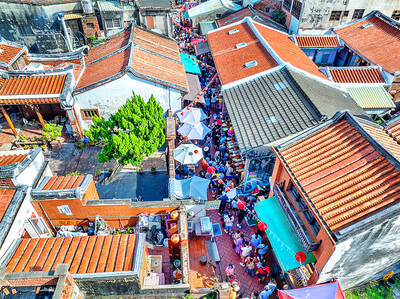Taipei Mayor Hau Lung-bin’s (郝龍斌) guarantee of the safety of the Maokong Gondola was challenged yesterday by Democratic Progressive Party (DPP) Taipei City councilors who cited geological reports to rebut the city government’s claim that support pillars are set into rocks beneath the surface.
Instead of “rocks,” what is beneath the surface of the gondola’s pillars is soft sandstone, and the city government was lying about the system’s safety, the councilors told a press conference at Taipei City Council.
“The city government has been telling the public that the pillars are set into hard rock and that there were no safety concerns. But the reports apparently told us another story. What lies underneath the surface are layers of sandstone and shale,” DPP Taipei City Councilor Chuang Ruei-hsiung (莊瑞雄) said.
Hau halted operations of the Maokong Gondola on Wednesday after a mudslide eroded the ground beneath a support pillar, but he insisted that the decision had only been taken to ease public anxiety.
Taipei City Secretariat Director Yang Hsi-an (楊錫安) said the pillars were set into igneous rock beneath the surface, so the stability of the pillars would not be affected if top soil eroded. Chuang and other DPP councilors presented two geology reports provided by China Engineering Consultants, the company asked by the Taipei City Government to analyze the geology of the area before the construction of the gondola system began. The reports showed that the components of subsoil were sandstone and shale.
“Where are the rocks? It’s all soft sand under the pillars. The city government is lying to us,” DPP Taipei City Councilor Hung Chien-yi (洪健益) said.
Yang said the layers of subsoil — from sandstone and shale to carbonate rock — have different levels of firmness. Subsoil that is 2m or deeper under the surface can be defined as “rock” in engineering terms.
The pillars are set more than 15m under the surface, and should be stable and safe, he said.
Shannon Lee (李咸亨), a civil engineering expert invited by the city government to evaluate the safety of the system, said after a municipal meeting yesterday that the civil engineering groups suggested steel posts be placed along the cliff to prevent rocks and soil from falling, and set up equipment to detect any moves of the stratum. The gondola system will not resume operations until the evaluation conducted by the groups of experts is completed and the groups have issued a report.
Meanwhile, National Taiwan University geography professor Lin Jiun-chuan (林俊全) said the debate between the Taipei City Council and the city government may have gotten off on the wrong foot.
“The foundation of the gondola station should be implanted into the sandstone level. There is no question about that as it appears to be the case with the station. However, the nature of sandstone levels vary widely,” he said.
Depending on the direction the sheets of rock are aligned, slopes can be either “dip slopes,” or “scarp slopes,” Lin said.
“While dip slopes have rock sheets pointing in the same direction as the slope and therefore are much more prone to landslides, scarp slopes have rock sheets that go against the slope and therefore are less likely to slide,” he said.
Investigations should be conducted to see which type of slope the system is built on, he said. If it turns out the system was built on a dip slope, Lin said that engineering and constructional techniques should be able to alleviate the problem.
Lin said he could not comment directly on the safety issue because he had not inspected the area.
ADDITIONAL REPORTING BY MEGGIE LU

An undersea cable to Penghu County has been severed, the Ministry of Digital Affairs said today, with a Chinese-funded ship suspected of being responsible. It comes just a month after a Chinese ship was suspected of severing an undersea cable north of Keelung Harbor. The National Communications and Cyber Security Center received a report at 3:03am today from Chunghwa Telecom that the No. 3 cable from Taiwan to Penghu was severed 14.7km off the coast of Tainan, the Ministry of Digital Affairs said. The Coast Guard Administration (CGA) upon receiving a report from Chunghwa Telecom began to monitor the Togolese-flagged Hong Tai (宏泰)

A cat named Mikan (蜜柑) has brought in revenue of more than NT$10 million (US$305,390) for the Kaohsiung MRT last year. Mikan, born on April 4, 2020, was a stray cat before being adopted by personnel of Kaohsiung MRT’s Ciaotou Sugar Refinery Station. Mikan was named after a Japanese term for mandarin orange due to his color and because he looks like an orange when curled up. He was named “station master” of Ciaotou Sugar Refinery Station in September 2020, and has since become famous. With Kaohsiung MRT’s branding, along with the release of a set of cultural and creative products, station master Mikan

RISING TOURISM: A survey showed that tourist visits increased by 35 percent last year, while newly created attractions contributed almost half of the growth Changhua County’s Lukang Old Street (鹿港老街) and its surrounding historical area clinched first place among Taiwan’s most successful tourist attractions last year, while no location in eastern Taiwan achieved a spot in the top 20 list, the Tourism Administration said. The listing was created by the Tourism Administration’s Forward-looking Tourism Policy Research office. Last year, the Lukang Old Street and its surrounding area had 17.3 million visitors, more than the 16 million visitors for the Wenhua Road Night Market (文化路夜市) in Chiayi City and 14.5 million visitors at Tainan’s Anping (安平) historical area, it said. The Taipei 101 skyscraper and its environs —

Taiwan on Friday said a New Zealand hamburger restaurant has apologized for a racist remark to a Taiwanese customer after reports that it had first apologized to China sparked outrage in Taiwan. An image posted on Threads by a Taiwanese who ate at Fergburger in Queenstown showed that their receipt dated Sunday last week included the words “Ching Chang,” a racial slur. The Chinese Consulate-General in Christchurch in a statement on Thursday said it had received and accepted an apology from the restaurant over the incident. The comment triggered an online furor among Taiwanese who saw it as an insult to the